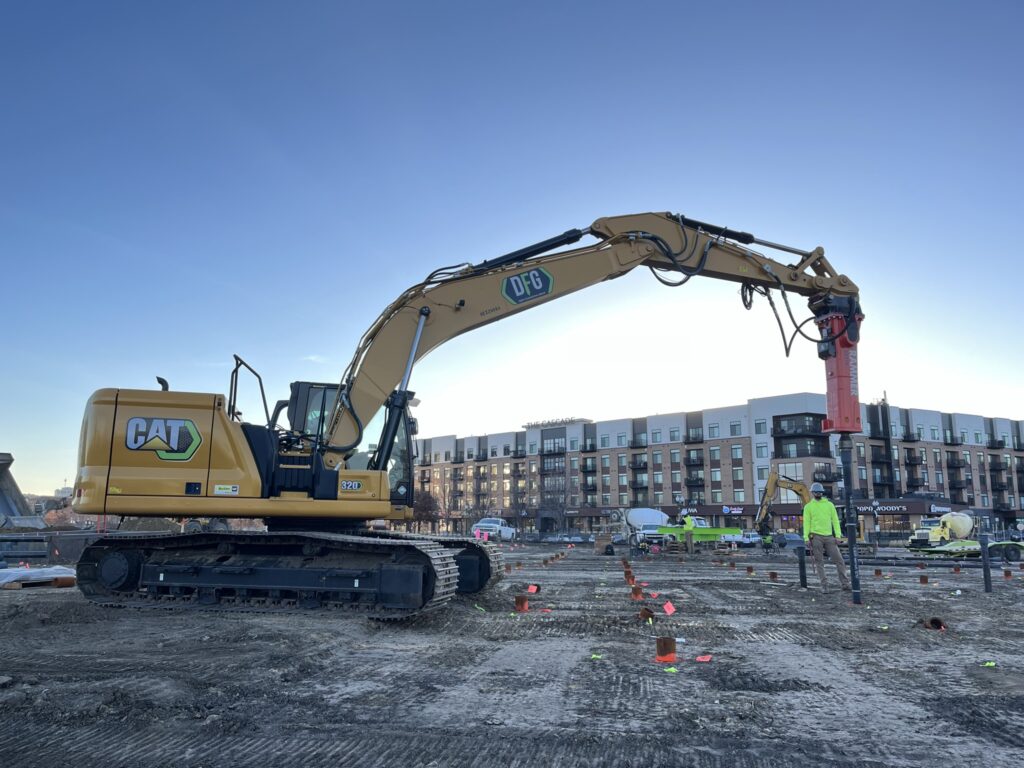Geotechnical Design of Ductile Iron Piles in Compression

If last month’s DuroTerra Dialogue on the Structural Design of Ductile Iron Piles, left you anxiously asking, “But what about the geotechnical capacity of Ductile Iron Piles?” we have good news! This month’s Dialogue focuses on the art of geotechnical design. Many of you have experience with Ductile Iron Piles being used on your projects across the United States to support allowable axial compression loads ranging from 25 tons to more than 100 tons. As noted in the structural design discussion, the design capacity of Ductile Iron Piles in compression depends on characteristics of the selected pile materials and the prevailing geotechnical conditions. Design capacities are determined by 1) calculating the structural capacity of the pile material (typically using allowable stress design), 2) estimating the allowable geotechnical capacity (soil resistance) and 3) selecting the more critical design mechanism (i.e. smaller of these two values).
 It’s often noted that a dozen geotechnical engineers working on the same problem will use a dozen different techniques to arrive at their individual solutions. The geotechnical design of Ductile Iron Piles, along with traditional piles for that matter, is not any different. While there are many different engineering approaches to estimate the geotechnical capacity, our new Tech Brief focusing on Geotechnical Design describes two common approaches used in the U.S. to evaluate the geotechnical capacity. The selected approach often depends on whether the Ductile Iron Pile is installed using an exterior grouted (“wet”) installation approach to form a grouted displacement pile or a “dry” installation approach where the pile is driven with no exterior grout (like a traditional pipe pile). Similar to the structural design approaches, these geotechnical methods are not unique to Ductile Iron Piles. The methods rely on technical resources from various industry publications including FHWA micropile design concepts, FHWA driven pile methods as well as information from national (i.e. IBC) and local building.
It’s often noted that a dozen geotechnical engineers working on the same problem will use a dozen different techniques to arrive at their individual solutions. The geotechnical design of Ductile Iron Piles, along with traditional piles for that matter, is not any different. While there are many different engineering approaches to estimate the geotechnical capacity, our new Tech Brief focusing on Geotechnical Design describes two common approaches used in the U.S. to evaluate the geotechnical capacity. The selected approach often depends on whether the Ductile Iron Pile is installed using an exterior grouted (“wet”) installation approach to form a grouted displacement pile or a “dry” installation approach where the pile is driven with no exterior grout (like a traditional pipe pile). Similar to the structural design approaches, these geotechnical methods are not unique to Ductile Iron Piles. The methods rely on technical resources from various industry publications including FHWA micropile design concepts, FHWA driven pile methods as well as information from national (i.e. IBC) and local building.
The new Tech Brief presents the common geotechnical methods to estimate capacities and also provides a few example exercises to demonstrate typical designs for various soil profiles. The Tech Brief, along with other technical and project resources, are available for download here. Have technical questions after reviewing or would like to evaluate a project? Please reach out to us via our website.
GULF HIGH SCHOOL ADDITION
New Port Richey, FL
With a mix of loose to medium dense sand and soft to stiff clay extending to highly variable limestone bedrock, construction of the new Gulf High School addition required a versatile foundation solution. The new 2-story, 90,000 sqft building had column and wall loads up to 250 kips and 7 klf, respectively. Some foundations also required tension resistance. Soil borings across the site revealed that the limestone bedrock was not only variable in depth ranging from 22 to 37 feet, but also highly variable in the degree of weathering. With a tight construction schedule and sensitivity to costs, the design team explored a variety of common foundation options and ultimately selected Ductile Iron Piles. One major advantage of the Ductile Iron Pile system is the ability to easily adjust pile lengths using the Plug and Drive connection system to handle highly variable rock depths without delays.
The project was specified for Ductile Iron Piles with capacities of 50 kips in compression and 5 kips of tension and lateral. EarthTech – a MENARD company designed a Series 118/7.5 Ductile Iron Pile (118 mm OD with 7.5 mm wall thickness) to provide the required capacities. A full-scale load test program was performed consisting of a compression test as well as tension and lateral tests. Results of the compression load test showed nearly linear behavior with just under ½-inch deflection at the 200% design load on the 31 ft pile. Upon unloading, the pile rebounded nearly elastically back to the origin. A lateral load test reacting against two piles showed movement of 1 inch at about 14 kips (280% DL). Deflection at the design load was limited to about ¼-inch, indicating acceptable performance. With a full-length center bar inserted in the pile for tension resistance, results showed less than 0.03” of movement at the 200% tension design load (only 10 kips).
EarthTech installed over 850 Ductile Iron Piles for the project. Pile lengths ranged from 10 to as much as 90 feet (with an average of about 32 feet) as a result of the highly variable limestone. Soils were so soft in locations that many piles advanced under the crowd of the excavator prior to driving into the rock. The resulting production was over 900 linear feet/crew day, which kept the project on the tight schedule. For more information on this and other projects, check out our projects page at duroterra.com/projects.








